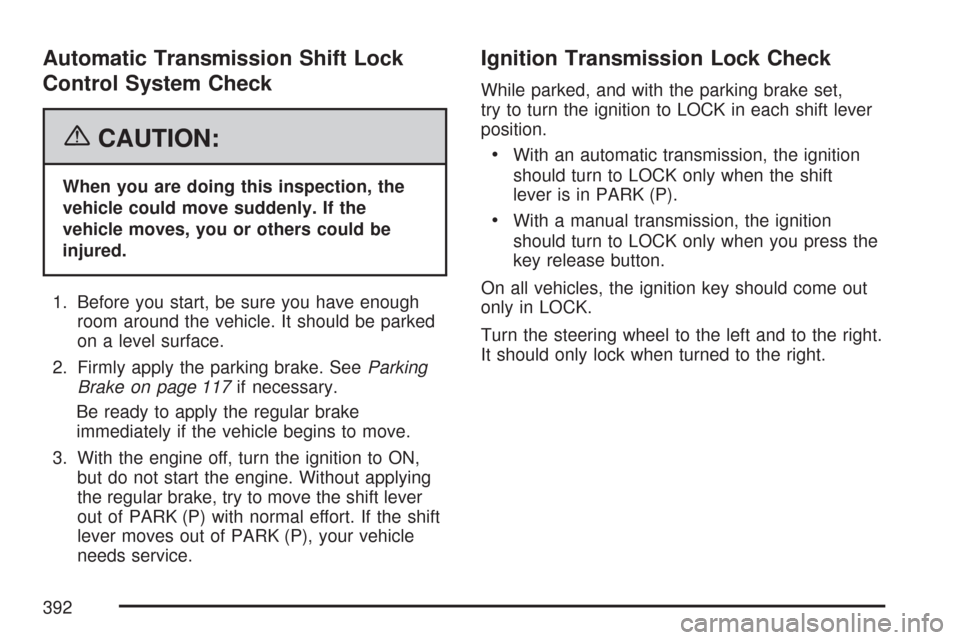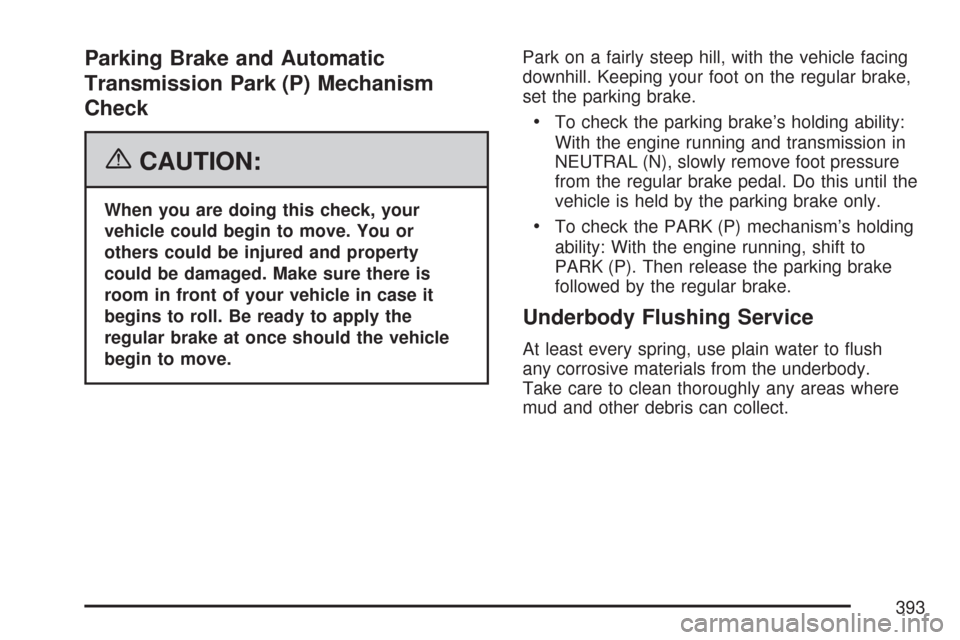Page 284 of 436

Checking the Fluid Level
Prepare your vehicle as follows:
1. Park your vehicle on a level place. Keep the
engine running.
2. With the parking brake applied, place the shift
lever in PARK (P).
3. With your foot on the brake pedal, move the
shift lever through each gear range, pausing
for about three seconds in each range.
Then, position the shift lever in PARK (P).
4. Let the engine run at idle for three to
five minutes.Then, without shutting off the engine, follow
these steps:
The automatic transaxle dipstick is located toward
the front of the engine compartment, near the
power steering fluid reservoir. SeeEngine
Compartment Overview on page 276for more
information on location.
1. Pull out the dipstick and wipe it with a clean
rag or paper towel.
2. Push the dipstick back in all the way, wait
three seconds and then pull it back out again.
3. Check both sides of the dipstick, fluid should
be between MIN and MAX mark of the hot
area of the dipstick.
4. If the fluid level is in the acceptable range,
push the dipstick back in all the way.
284
Page 305 of 436

To avoid the possibility of the vehicles rolling,
set the parking brake firmly on both vehicles
involved in the jump start procedure. Put
an automatic transaxle in PARK (P) or
a manual transaxle in NEUTRAL before
setting the parking brake.
Notice:If you leave your radio or other
accessories on during the jump starting
procedure, they could be damaged. The repairs
would not be covered by your warranty.
Always turn off your radio and other
accessories when jump starting your vehicle.
3. Turn off the ignition on both vehicles.
Unplug unnecessary accessories plugged into
the cigarette lighter or the accessory power
outlet. Turn off the radio and all lamps that are
not needed. This will avoid sparks and help
save both batteries. And it could save
the radio!4. Open the hoods and locate the batteries. Find
the positive (+) and negative (−) terminal
locations on each vehicle. Your vehicle’s
positive (+) terminal is located under a
red tethered cap on the battery. SeeEngine
Compartment Overview on page 276for more
information on location.
Flip the cap up to access the positive (+)
terminal.
{CAUTION:
An electric fan can start up even when the
engine is not running and can injure you.
Keep hands, clothing and tools away from
any underhood electric fan.
305
Page 336 of 436
Changing a Flat Tire
If a tire goes flat, avoid further tire and wheel
damage by driving slowly to a level place. Turn on
your hazard warning flashers.
{CAUTION:
Changing a tire can be dangerous. The
vehicle can slip off the jack and roll over
or fall on you or other people. You and
they could be badly injured or even killed.
Find a level place to change your tire. To
help prevent the vehicle from moving:
1. Set the parking brake �rmly.
2. Put an automatic transaxle shift lever
in PARK (P), or shift a manual
transaxle to FIRST (1) or REVERSE (R).
CAUTION: (Continued)
CAUTION: (Continued)
3. Turn off the engine and do not restart
while the vehicle is raised.
4. Do not allow passengers to remain in
the vehicle.
To be even more certain the vehicle will
not move, you should put blocks at the
front and rear of the tire farthest away
from the one being changed. That would
be the tire on the other side, at the
opposite end of the vehicle.
336
Page 363 of 436
Fuses Usage
LOW BEAM RT Passenger’s Side Headlamp Low
ILLUM RTParking Lamp Right Side,
Illumination Circuit
LOW BEAM LT Driver’s Side Headlamp Low
ILLUM LTDriver’s Side Parking Lamp, License
Plate Lamp
INT LTS Room Lamp
BLANK Not Used
DEFOG Defogger
S/ROOF Sunroof
ILLUM LAMPS Illumination Relay
HORN Horn
HEAD LAMPS Headlamps
FUEL Fuel PumpFuses Usage
A/C Air Conditioning Compressor
FOG LAMPS Front Fog Lamp
HVAC
BLOWERHeating, Ventilation, Air
Conditioning Blower
ABS Anti-lock Brake System
I/P FUSE
BATT.Instrument Panel Fuse Box
COOL FAN Radiator Fan
IGN 2 Ignition 2
BLANK Blank
IGN 1 Ignition 1
PWR WNDW Power Windows
SPARE Spare
363
Page 391 of 436
Starter Switch Check
{CAUTION:
When you are doing this inspection, the
vehicle could move suddenly. If the
vehicle moves, you or others could be
injured.
1. Before you start, be sure you have enough
room around the vehicle.
2. Firmly apply both the parking brake and the
regular brake. SeeParking Brake on page 117
if necessary.
Do not use the accelerator pedal, and be
ready to turn off the engine immediately if
it starts.3. On automatic transmission vehicles, try to
start the engine in each gear. The starter
should work only in PARK (P) or
NEUTRAL (N). If the starter works in any
other position, your vehicle needs service.
On manual transmission vehicles, put the shift
lever in NEUTRAL, push the clutch pedal
down halfway and try to start the engine.
The starter should work only when the clutch
pedal is pushed down all the way to the
floor. If the starter works when the clutch pedal
is not pushed all the way down, your vehicle
needs service.
391
Page 392 of 436

Automatic Transmission Shift Lock
Control System Check
{CAUTION:
When you are doing this inspection, the
vehicle could move suddenly. If the
vehicle moves, you or others could be
injured.
1. Before you start, be sure you have enough
room around the vehicle. It should be parked
on a level surface.
2. Firmly apply the parking brake. SeeParking
Brake on page 117if necessary.
Be ready to apply the regular brake
immediately if the vehicle begins to move.
3. With the engine off, turn the ignition to ON,
but do not start the engine. Without applying
the regular brake, try to move the shift lever
out of PARK (P) with normal effort. If the shift
lever moves out of PARK (P), your vehicle
needs service.
Ignition Transmission Lock Check
While parked, and with the parking brake set,
try to turn the ignition to LOCK in each shift lever
position.
•With an automatic transmission, the ignition
should turn to LOCK only when the shift
lever is in PARK (P).
•With a manual transmission, the ignition
should turn to LOCK only when you press the
key release button.
On all vehicles, the ignition key should come out
only in LOCK.
Turn the steering wheel to the left and to the right.
It should only lock when turned to the right.
392
Page 393 of 436

Parking Brake and Automatic
Transmission Park (P) Mechanism
Check
{CAUTION:
When you are doing this check, your
vehicle could begin to move. You or
others could be injured and property
could be damaged. Make sure there is
room in front of your vehicle in case it
begins to roll. Be ready to apply the
regular brake at once should the vehicle
begin to move.Park on a fairly steep hill, with the vehicle facing
downhill. Keeping your foot on the regular brake,
set the parking brake.
•To check the parking brake’s holding ability:
With the engine running and transmission in
NEUTRAL (N), slowly remove foot pressure
from the regular brake pedal. Do this until the
vehicle is held by the parking brake only.
•To check the PARK (P) mechanism’s holding
ability: With the engine running, shift to
PARK (P). Then release the parking brake
followed by the regular brake.
Underbody Flushing Service
At least every spring, use plain water to flush
any corrosive materials from the underbody.
Take care to clean thoroughly any areas where
mud and other debris can collect.
393
Page 395 of 436
Fuel System Inspection
Inspect the complete fuel system for damage
or leaks.
Engine Cooling System Inspection
Inspect the hoses and have them replaced if
they are cracked, swollen or deteriorated.
Inspect all pipes, fittings and clamps; replace as
needed. Clean the outside of the radiator and
air conditioning condenser. To help ensure proper
operation, a pressure test of the cooling system
and pressure cap is recommended at least once
a year.
Brake System Inspection
Inspect the complete system. Inspect brake lines
and hoses for proper hook-up, binding, leaks,
cracks, chafing, etc. Inspect disc brake pads for
wear and rotors for surface condition. Also inspect
drum brake linings for wear and cracks. Inspect
other brake parts, including drums, wheel
cylinders, calipers, parking brake, etc. Check
parking brake adjustment. You may need to have
your brakes inspected more often if your driving
habits or conditions result in frequent braking.
395